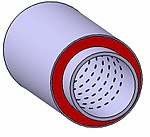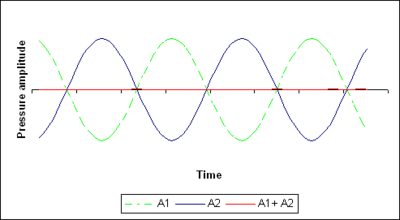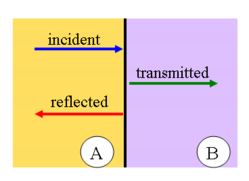Acoustics/Car Mufflers
Introduction
[edit | edit source]A car muffler is a component of the exhaust system of a car. The exhaust system has mainly 3 functions:
- Getting the hot and noxious gas from the engine away from the vehicle
- Reduce exhaust emission
- Attenuating the noise output from the engine
The last specified function is the function of the car muffler. It is necessary because the gas coming from the combustion in the pistons of the engine would generate an extremely loud noise if it were sent directly in the ambient air surrounding engine through the exhaust valves. There are 2 techniques used to dampen the noise: absorption and reflection. Each technique has its advantages and disadvantages.

The absorber muffler
[edit | edit source]The muffler is composed of a tube covered by sound absorbing material. The tube is perforated so that some part of the sound wave goes through the perforation to the absorbing material. The absorbing material is usually made of fiberglass or steel wool. The dampening material is protected from the surrounding by a supplementary coat made of a bend metal sheet.
The advantage of this method is low back pressure with a relatively simple design. The inconvenience of this method is low sound damping ability compared to the other techniques, especially at low frequency.
The mufflers using the absorption technique are usually sports vehicle because they increase the performances of the engine because of their low back pressure. A trick to improve their muffling ability consists of lining up several "straight" mufflers.
The reflector muffler
[edit | edit source]Principle: Sound wave reflection is used to create a maximum amount of destructive interferences

Definition of destructive interferences
[edit | edit source]Let's consider the noise a person would hear when a car drives past. This sound would physically correspond to the pressure variation of the air which would make his ear-drum vibrate. The curve A1 of the graph 1 could represent this sound. The pressure amplitude is a function of the time at a certain fixed place. If another sound wave A2 is produced at the same time, the pressure of the two waves will add. If the amplitude of A1 is exactly the opposite of the amplitude A2, then the sum will be zero, which corresponds physically to the atmospheric pressure. The listener would thus hear nothing although there are two radiating sound sources. A2 is called the destructive interference.

Definition of the reflection
[edit | edit source]The sound is a traveling wave i.e. its position changes in function of the time. As long as the wave travels in the same medium, there is no change of speed and amplitude. When the wave reaches a frontier between two mediums which have different impedances, the speed, and the pressure amplitude change (and so does the angle if the wave does not propagate perpendicularly to the frontier). The figure 1 shows two medium A and B and the 3 waves: incident transmitted and reflected.
Example
[edit | edit source]If plane sound waves are propagating across a tube and the section of the tube changes, the impedance of the tube will change. Part of the incident waves will be transmitted through the discontinuity and the other part will be reflected.
Mufflers using the reflection technique are the most commonly used because they dampen the noise much better than the absorber muffler. However they induce a higher back pressure, lowering the performance of the engine (an engine would be most efficient or powerful without the use of a muffler).
The upper right image represents a car muffler's typical architecture. It is composed of 3 tubes. There are 3 areas separated by plates, the part of the tubes located in the middle area are perforated. A small quantity of pressure "escapes" from the tubes through the perforation and cancel one another.
Some mufflers using the reflection principle may incorporate cavities which dampen noise. These cavities are called Helmholtz Resonators in acoustics. This feature is usually only available for up market class mufflers.
Back pressure
[edit | edit source]Car engines are 4 stroke cycle engines. Out of these 4 strokes, only one produces the power, this is when the explosion occurs and pushes the pistons back. The other 3 strokes are necessary evil that don't produce energy. They on the contrary consume energy. During the exhaust stroke, the remaining gas from the explosion is expelled from the cylinder. The higher the pressure behind the exhaust valves (i.e. back pressure), the higher the effort necessary to expel the gas out of the cylinder. So, a low back pressure is preferable in order to have a higher engine horsepower.
Muffler modeling by transfer matrix method
[edit | edit source]This method is easy to use on computer to obtain theoretical values for the transmission loss of a muffler. The transmission loss gives a value in dB that correspond to the ability of the muffler to dampen the noise.
Example
[edit | edit source]P stands for Pressure [Pa] and U stand for volume velocity [m3/s]
= and = and =
So, finally: =
with
=
Si stands for the cross section area
k is the wave number
is the medium density
c is the speed of sound of the medium
Results
[edit | edit source][Matlab code] of the graph above.
Comments
[edit | edit source]The higher the value of the transmission loss and the better the muffler.
The transmission loss depends on the frequency. The sound frequency of a car engine is approximately between 50 and 3000 Hz. At resonance frequencies, the transmission loss is zero. These frequencies correspond to the lower peaks on the graph.
The transmission loss is independent of the applied pressure or velocity at the input.
The temperature (about 600 Fahrenheit) has an impact on the air properties : the speed of sound is higher and the mass density is lower.
The elementary transfer matrix depends on the element which is modelled. For instance the transfer matrix of a Helmotz Resonator is with
The transmission loss and the insertion loss are different terms. The transmission loss is 10 times the logarithm of the ratio output/input. The insertion loss is 10 times the logarithm of the ratio of the radiated sound power with and without muffler.
Links
[edit | edit source]- General Information about Filter Design & Implementation
- More information about the Transfer Matrix Method
- General information about car mufflers
















